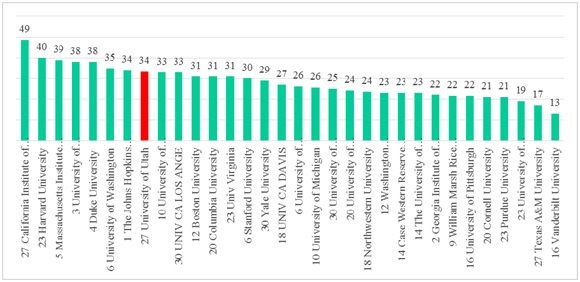
A recent program wide evaluation of the Department of Biomedical Engineering commissioned a study to assess the scholarly impact and productivity of its faculty, benchmarked against its US News and World Report peers. It compared the median h-index and median total number of citations using google scholar as its data source and compared PhD productivity and BS degree productivity per tenured and tenure track faculty using last year’s ASEE data.
The study was conducted in the spring of 2014 and showed that the median h-index for Department of Biomedical Engineering faculty at the University of Utah was 34, which tied with Johns Hopkins. Institutions in the top 6 included California Institute of Technology, Harvard, MIT, UCSD, Duke and the University of Washington.
The Department ranked 12th in the median number of citations among is core faculty at 3,762, tied for 12th with 0.9 PhDs produced per tenured and tenured track faculty and was found to produce 2.8 BS degrees per tenured and tenured track faculty.
The h-index, as proposed by Jorge E. Hirsch, Dept. of Physics, University of California San Diego, gives an estimate of the
importance, significance, and broad impact of a scientist’s cumulative research contributions.
The Department of Biomedical Engineering at the University of Utah is one of the oldest in the nation. It was established in 1972 and has 25 tenured and tenure track faculty. With 13 new faculty added in the last 8 years, it is one of the fastest growing Departments of its kind in the US. Last year alone, the Department added 4 new FTE to its ranks and graduated 27 PhDs, which places it among the nation’s elite BME departments. The graph above ranks the Departments by median h-index as determined using a data mining approach of google scholar. The number below each Department is its 2014’s US News and World Report Ranking